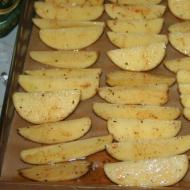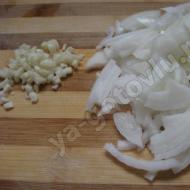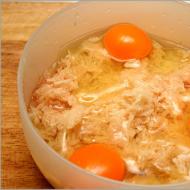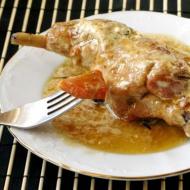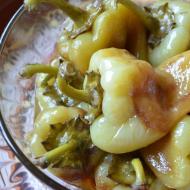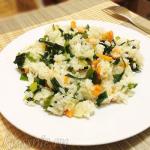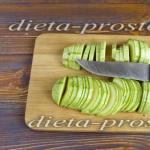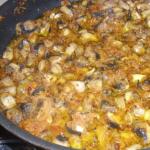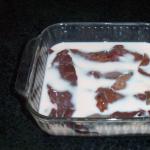
Head salad Berlin yellow. Berlin yellow head salad Berlin yellow
Properly selected varieties of lettuce will help diversify the summer menu and fill the diet with biologically useful substances, fiber, trace elements and vitamins. It is necessary to choose the right varieties of leaf lettuce.
Salad It is an annual plant from the Asteraceae family. Its homeland is the Mediterranean coast. Lettuce is one of the oldest cultivated vegetable crops. It was grown by the ancient Egyptians, Romans and Greeks. It entered Russia in the 12th century. Currently, lettuce is widely cultivated in all countries of the world, being one of the main vegetable crops. In our country, lettuce is cultivated on a small scale, and its production is concentrated near large cities; many gardeners willingly grow it in their backyards.
Salad- an extremely valuable early ripening vegetable crop. It contains almost all currently known vitamins, a significant amount of salts of iron, potassium, calcium, phosphorus, organic acids, pectins, folic acid. Due to the high content of these physiologically active compounds, lettuce improves metabolism, improves blood composition, normalizes the functioning of the gastrointestinal tract, and increases vitality. The use of lettuce in the daily diet is an excellent prophylactic against many diseases.
Of the nutrients in the leaves, the substances contain 1.2% sugar, 2.3% protein. Lettuce leaves are used in their raw form mainly for the preparation of various salads, while the leaves are used only until the formation of a flower arrow, since with its appearance the leaves develop a bitter taste. Lettuce has three varieties: leaf, head and romaine lettuce: leaf lettuce forms only a rosette of juicy leaves; head lettuce forms more or less dense small heads of rounded or rounded flat shape; romaine lettuce forms elongated heads.
The leaves are light, yellow and dark green, sometimes with red or brown anthocyanin pigmentation in the form of spots along the edges or all over the surface. The edge of the leaf is solid, serrated, wavy, scalloped, and the surface of the leaf itself is from smooth to strongly bubbled. The flower-bearing stem is 60-100 cm high, the inflorescence is a basket, the seeds are small with a tufted fly. Lettuce is a self-pollinating crop.

Salad- long-day cold-resistant culture, can grow at + 5 °C, the optimum temperature for growth is + 18 °C. Plants easily tolerate light frosts.
Lettuce makes high demands on soil fertility and moisture. With a lack of moisture, the yield drops sharply, the plant quickly switches to flowering. Excessive moisture leads to a strong defeat of the leaves by fungal diseases. Head lettuce is more demanding on light intensity than leaf lettuce.

Moscow greenhouse. Leaf lettuce of medium early ripening, from mass shoots to the onset of economic suitability, 45-60 days pass, but in our gardens they practically begin to harvest it much earlier. The rosette of leaves is semi-raised, about 22 cm in diameter. The leaf is pale green, entire. The texture of the leaves is delicate, the taste is sweet, without bitterness. The mass of one plant is 70 - 100 grams. The grade is widely used at cultivation on early production in the open and protected ground.

Large-headed. Mid-season variety. Vegetation period 54–67 days. The rosette is semi-raised, large, 30–35 cm in diameter. The head is round-oval, 10–14 cm in diameter. The weight of one plant is 260–550 g, the weight of one head is 130–325 g. yellow-green. The grade is used for cultivation in an open ground and in film greenhouses.

Salad Festival
Salad Festival- this is a mid-season variety, from germination to technical ripeness 71 days. The socket is large, the head of cabbage is rounded, dense. The mass of one plant is 115–300 g, the mass of a head of cabbage is 90–125 g. It is recommended for cultivation in open ground.

Berlin yellow salad
Berlin yellow salad- this is a mid-season variety, from germination to technical ripeness 73 days. Rosette with a diameter of 24–29 cm, the leaf is light green with yellowness. The head of cabbage is round, loose or medium density, light yellow, weighing 104–200 g. It is recommended for cultivation in open ground and film greenhouses.

Salad Kucheryavets
Salad Kucheryavets- this is a medium-late variety, the period from germination to technical ripeness is 68–75 days. The leaf is light green, the edge of the leaf is scalloped. Head loose, weighing about 200 grams. Recommended for cultivation in open and protected ground.
Other varieties are also cultivated, such as: Riga, Azart, Kucheryavets, Gribovsky, New Year.
Varieties of head lettuce of Dutch selection: Amulet, Bastion, Vicki, Crestel, Sanora.
Agricultural technology
In the garden, lettuce should be grown in the second year after applying organic fertilizers. If organic fertilizers were not applied under the previous crop, then 4–5 kg / m2 of humus or compost are directly given under the salad. With a small garden plot, a separate area is not allotted for lettuce: it is grown in front of late-grown crops, tomato and mid-ripening cabbage, or as a compactor for other plants. To create a conveyor for the continuous flow of fresh produce, sowing should be carried out in small areas with an interval of 10-14 days, starting from the end of April. Areas with the earliest sowing time should be covered with a film, which will further accelerate the flow of the crop. Leaf lettuce is sown row by row at a distance of 15–20 cm, head lettuce - 25–30 cm, the seeds are planted to a depth of 1.5–2.0 cm, after sowing the rows are mulched.
General plant care- weeding, thinning, loosening, watering. With dense seedlings, the plants stretch out, are easily affected by diseases, and head varieties do not form a head. Leaf lettuce is thinned out when shoots appear, leaving 2 cm between plants in a row, thinned out again in the phase of 3 true leaves - by 7 cm. For head lettuce, 8 cm is left during the first thinning, and 25 cm at the second, depending on the variety. In fertile areas, fertilizing is not carried out. Water the salad sparingly. Excess moisture is especially dangerous after the leaves close in rows and head out.
For an earlier harvest, you can use the seedling method of growing. Sowing is carried out in early April in small boxes, seedlings in the phase of the first true leaf dive into pots with a diameter of 5 cm or into boxes according to the scheme 5–5 cm. By the time of planting, the seedlings should have 4 true leaves.
Harvest as heads or rosettes of leaves are formed. Leaf lettuce is usually pulled out with the root system, and in head varieties, the head is cut off with a knife and the lower damaged and yellowed leaves are removed. Cleaning is best done in the morning, but only when the leaves are dry from dew. Store lettuce in perforated plastic bags, avoiding wilting heads or rosettes.
salad dishes
Lettuce is eaten mainly raw for preparing various vegetable salads, but it is also boiled and fried. We offer simple and delicious salad dishes for home cooking.

Sandwiches with salad. Sandwiches will be tastier and healthier if slices of bread, spread with butter, are covered with lettuce leaves, and pieces of meat, ham or fish (sprat, herring, sardines) are placed on top.

Salad with cucumbers and tomatoes. Cut the washed and dried lettuce leaves, cucumbers and tomatoes and put them in a salad bowl. Season with sour cream and finely chopped hard-boiled egg. Salt, sugar, vinegar add to taste. In order for the salad not to lose its tenderness, it should not be prepared in advance, before serving.

Salad with vinegar and oil. Cut the washed and dried leaves and put in a salad bowl. Before serving, pour vegetable oil and vinegar on the table, mix, sprinkle with dill or parsley, salt.

Salad soup. Scald the leaves with boiling water, put in a colander, pour over with cold water, let the water drain, then lightly sauté with butter, add milk sauce and cook at a low boil for 20 minutes, then wipe, and bring to a boil in the same sauce. Fill with cream and butter.

stewed salad. Cut 7 heads of lettuce into 4 parts, rinse well and simmer under a lid in a small amount of butter. Add 300 g of sour cream sauce, dilute with meat broth. Before serving, add 100 g of green peas stewed in butter.
Agricultural technology
How to plant
Before sowing or planting lettuce seedlings, the soil is carefully dug up, clods of earth are crushed, fertilizers are applied: potassium salt, superphosphates, ammonium. The soil, which is characterized by high acidity, is limed in advance. Sowing lettuce is carried out in a stepwise way, the timing of which is determined by the selected variety. Headed species are planted using the line method, leafy species are planted using the standard method, observing a distance between seeds of 1.5 cm with a sowing depth of about 0.5–1 cm.cultivation
The culture responds very well to the introduction of nitrogen, but it is impossible to overdo it with its use - nitrates and nitrites accumulate in the leaves, which is harmful to health. The plant is periodically weeded, the soil is loosened, a systematic check is made for the presence of beetles and tears that love lettuce. It is impossible to neglect watering, loosening the crust formed on the ground.
Harvesting
With the exception of some varieties, it is undesirable to overgrow lettuce, as its leaves become bitter. Harvesting is carried out as the plants mature, a complete cleaning of the site is not excluded. The leaves are stored in bags at a temperature of about 2 ° C for 1-2 weeks. Headed lettuces are cut at the root, stacked several pieces in a container and placed in dark rooms under the film.
Fresh, chilled, crunchy salads are a delicious treat. Diverse in shape, leaf and color, these fast-growing annual vegetables are mostly used fresh. In almost any garden there is a place for a head lettuce. It is very unpretentious and grows in almost any soil. It takes very little knowledge to harvest lettuce throughout the summer season. It is better to plant several different types of lettuce, and then there will be a wide selection of this vegetable with very different leaves in shape and color.

Lettuce seeds can be sown immediately in open ground, and for greenery in early spring, plants are grown through seedlings or in greenhouses.
According to the lunar calendar in 2020, favorable days for sowing lettuce seeds are:
- in January: 1, 17, 28, 29;
- in February: 6th, 7th, 24th, 25th;
- March is the best day 4, 5, 6 (before lunch), you can start planting 17, 18, 22, 23;
- in April: 1 and 2 best days, can be sown on 13, 14, 18, 19;
- in May: 25, 26 or 11, 12, 15, 16;
- in June: 7, 8, 12, 13, 22, 23.
Unfavorable days for sowing and planting:
- January: 10, 25;
- February: 9, 23;
- March: 9, 24;
- April: 8, 23;
- May: 7, 22;
- June: 5, 21.

The best varieties of lettuce
Leaf lettuce is divided into types. A list of popular varieties is provided. Among them there are head types and without a core, fast ripening and with a relatively long wait for the harvest:
| Greenhouse Moscow: terms - 1-1.5 months; taste: sweetish; color: light green; long-term storage. |
High Yielding Variety – Design. Strong immunity, green leaf, late ripening. | |
| Sandwich. Refers to the early maturing. The edges of the foliage are wavy. Color: light green. | Grows well at home "Four Seasons". The shade is bronze with a red tint, but the inside is yellow-green. | Festival.Terms of full maturation - 65-70 days. Light green leaf color. |
| Fun. Mid-season with strong immunity. Color: bright red. | The special shape of the leaves (triangular) in Attraction. The variety is mid-season, with light green leaves. | The mid-season varieties of this species include Eurydice. Lettuce is dark green. The taste is special. |
| Ballet. Strong immune system. Suitable for growing indoors. The foliage is fan-shaped, the edges are scalloped. Colour: dark green. | Lettuce is not afraid of the active sun great lake. Terms for ripening: 80-90 days. Color: dark green. The shape of the leaves resembles oak. | Gribkovsky kucheryavets- the owner of strong immunity with bright green leaves. The shape is fan-shaped with a small corrugated edge. |
| Emerald. Not afraid of drought and heat. The color matches the name. The leaves are finely bubbly. Differs in taste. | Good result will be when disembarking iceberg. Variety with good immunity, pleasant taste. The only negative is the long maturation: up to 3 months. | Yellow Berlin lettuce can be seen by color: bright yellow. |
| Cricet. Differs in the increased resistance to adverse weather conditions. The foliage is light green in color. Maturing terms up to 45 days, but not less than a month. |

Site selection and preparation
The plant is a big light lover. Therefore, his place in the sun. We do not forget that the head of cabbage is especially bad without the sun, because at the same time it is hardly possible to wait for a bunch of heads of cabbage from it.
As for the soil, for growth we select fertile, loose, moderately moist soil, just in moderation, since various diseases may occur when waterlogged.
Comfortable soil is a soil that has a neutral reaction, however, with a good addition of nutrients, it also feels good on slightly acidic soil.
Seeding rules
First, prepare a suitable soil mixture. To do this, mix high-quality humus soil, peat and sand (2: 1: 1). If there is an opportunity and desire, then buy a ready-made earthen mixture that can be found on the store shelf, Vegetable, Universal and Biogrunt are best suited. Sowing is recommended to be carried out in containers or boxes, but experienced gardeners advise using pressed peat cubes with a 40–50 mm edge for this.
Just before sowing, the seeds are immersed for 2–3 hours in a solution of pink potassium manganese. Then they are evenly distributed on the surface of the substrate, without embedding. If sowing is carried out in a box, then grooves must first be made in the soil mixture, into which the seeds are evenly placed, while they should be buried in the substrate by no more than 10 mm. If, as the seedlings grow, you want to pick them up, then the row spacing should be about 50 mm. But you can not dive seedlings, in this case it is necessary to leave a distance of at least 100 mm between rows. Crops need abundant watering, which must be carried out very carefully, then the container is covered with glass or film on top. Experts advise to remove seedlings in a well-lit place with an air temperature of 18 to 21 degrees. The first seedlings may appear after 3-4 days, immediately after that the temperature should be reduced by 3 or 4 degrees, otherwise the plant may begin to stretch.
If the bushes need picking, then it is carried out after 1 or 2 true leaf plates are formed on them. Seedlings are planted in open soil during the formation of 3 or 4 true leaf blades. But before they need to be hardened for 15 days. To do this, every day the seedlings are transferred to the street, while the duration of such a procedure should be increased gradually. Seedlings will harden completely after they can stay in the fresh air around the clock. If the lettuce is grown indoors, then it does not need to be hardened.
Seedling care
There is no difficulty in caring for a salad. The main requirements were: timely and frequent watering, regular loosening, thinning and elimination of weeds.
In the spring, it is advisable to cover the young with cones at night to provide protection. Remove fixtures during the day.

Outdoor lettuce care
In order to successfully cultivate lettuce on your site, it is necessary to weed it in a timely manner, water it, and also loosen the soil surface near the bushes. It is recommended to loosen the soil every time after rain or watering; during this procedure, all weeds must be removed from the garden.
Watering
When grown in open soil, the bushes are watered regularly on average 1 time in 7 days and do this in the evening or morning. When growing head varieties, it is recommended to water them along the rows, but the sprinkling method is better suited for leafy varieties. After the growth of heads of cabbage begins on the bushes, watering should be sharply reduced, otherwise there is a high probability of rot on the bushes. On hot days, to prevent the development of necrosis in lettuce, experts advise watering it at night. Remember that the frequency of watering is directly dependent on weather conditions.
Fertilizer
When growing leafy varieties, it is enough to add all the necessary fertilizers to it when preparing the soil for planting, and then the bushes will not need to be fed. However, if the soil is depleted, then to obtain crisp lettuce foliage, plants should be fed with phosphorus, calcium, nitrogen, potassium and magnesium. Since head varieties grow longer than leaf varieties, they should be fertilized 1-2 times during the season. It is recommended to feed the bushes with organic matter, namely: a solution of bird droppings (1:20), fermented herbal infusion, biohumus or a solution of mullein (1:10). As a rule, the plant is fed at the same time as watering.

Growing lettuce in a greenhouse
Since lettuce seeds can hatch at a temperature of +5 degrees, it can be planted and grown in a greenhouse even in winter, provided that the room is heated. However, in the future, the plant needs a temperature of about +20 degrees for growth and development. Therefore, lettuce seeds can be planted in an unheated greenhouse from mid-March to the end of April (depending on the region).
- Add 15 grams of potassium chloride and 40 grams of superphosphate for each square meter.
- Dig the soil along with fertilizers.
- If the soil is acidic, then it is recommended to add slaked lime or dolomite flour (the norms depend on the degree of soil acidity). Also, the level of acidity will help to even out rotted manure.
In the spring, the bed needs to be loosened, leveled and grooved at a distance of 10 cm from each other. Seeds are laid to a depth of 1-2 cm, sprinkled with soil and watered. Since freezing temperatures are not uncommon in early spring, it is recommended to sprinkle the bed with mulch in the form of fine humus.
When the seedlings sprout and grow a little, they are thinned out so that the distance between the specimens is from 15-20 cm.
Lettuce care in the greenhouse
Care consists in abundant, but not frequent watering, weeding and loosening of the soil, top dressing. Fertilize twice during the growing season. The last top dressing should be done no later than a month before harvest. As a fertilizer, use a solution of 10 liters of water and ammonium nitrate with potassium chloride (half a teaspoon of each preparation).

Growing lettuce on a windowsill
Lettuce on the windowsill can be grown throughout the year. For sowing seeds, you can use pots with a volume of 1-2 liters or boxes. In the spring, they are placed in a well-lit place (a sunny window is perfect). In the cold season, the bushes will need additional illumination, for this they use phytolamps or fluorescent lamps, as a result, the duration of daylight hours should be increased by 2-3 hours.
For growing lettuce on a window, the soil mixtures described above are well suited, but a substrate consisting of coconut fiber and biohumus (2: 1) can also be used. Prepare the seed material in the same way as described above. Then take a container, lay a good layer of drainage on its bottom and fill it with a moist soil mixture, after which seeds are sown into it to a depth of 0.5–1 centimeter. After the crops are watered, they must be covered with glass (film) from above, and then put away in a dark place. The first seedlings should appear after 3-5 days, immediately after that the shelter is removed, and the container is moved to a well-lit place. It will be possible to pluck foliage for food after 5 to 10 plates form on the bushes. If you are going to store the cut leaves, then you should never wash them, otherwise rot will form on them.
Watering
When growing on a window, you need to water the lettuce systematically 1 time in 2-3 days. Particular attention should be paid to watering on hot days, because drying out the earthy coma causes faster formation of flower arrows, and because of this, an unpleasant bitter taste appears in the foliage. Seedlings grow well at a temperature of 16 to 20 degrees, but it also develops normally on a cool loggia (about 6-7 degrees). Such a plant can be harmed not only by cold, but also by excessive heat, as well as low air humidity, in connection with this, the bushes must be moistened every day from a sprayer. To moisten and water the salad, use well-settled water at room temperature.
Fertilizer
In order for the salad to grow actively at room conditions, it will need to be fed in a timely manner. To do this, complex fertilizer in liquid form is applied to the soil mixture once every 7 days. Remember that this crop can accumulate nitrates, in this regard, it is necessary to control the amount of nitrogen introduced into the soil mixture. But it is best to use organic fertilizer for top dressing, for example, a solution of mullein (1:10).

lettuce pests
Of the pests, the tender plant is most often annoyed by slugs and aphids, cruciferous flea and wireworm. Since chemicals are absorbed into the leaves, they cannot be used, so it is recommended to use folk remedies:
- Holes in the leaves indicate that the plant is eating cruciferousflea. Good preventive measures are weeding and regular watering (the flea does not like moisture). Planting a number of marigolds, calendula, tomatoes, garlic will scare away the pest.
- lettuce aphid It feeds on plant sap, the leaves of which begin to darken and curl. This insect will scare away the onions planted nearby. You can get rid of a white-winged insect with the help of an infusion of young potato tops, dandelion leaves or onion husks.
- Slugs they eat the lower leaves, on which large holes form as a result. Traps are made for these pests: disposable cups are dug in the garden, into which a little syrup, juice or beer is poured. The best remedy for slugs is beer, which is fatal to them. However, pests are very fond of this drink, so if the traps are placed in the evening, in the morning you will see many dead slugs in them.
- wireworm eats plant roots. To destroy these pests, there are many folk methods, which we wrote about in our article " How to get rid of the wireworm in the garden».

lettuce diseases
Under adverse conditions, non-compliance with crop rotation and agricultural technology, lettuce is affected by diseases, among which the following are most dangerous for plants:
- white rot- a fungal disease manifests itself as a flaky coating on the leaves and watery light spots on the stems. In part of the plant, the infection penetrates through leaves touching the ground.
- Gray rot affects plants at high humidity and cloudy weather. The fungus also penetrates through leaves lying on the ground, on which brown necrotic spots appear. Spotting from the bottom of the heads and stems goes to the top and spreads throughout the plant. Lettuces are resistant to gray rot - Maisky, Khrustalny, Moscow greenhouse.
- powdery mildew- a disease that can be recognized by a white coating that does not look like pieces of cotton wool on foliage, heads of cabbage and stems.
- marginal burn- the disease manifests itself and spreads rapidly with an excess of nutrients in the soil. The affected plant quickly dies.
- downy mildew infects the culture at high humidity. The lower leaves are covered with white bloom, and the upper ones with yellow spots. After a while, diseased leaves turn brown and dry up.
Since chemicals cannot be used to treat diseases on lettuce, preventive measures will become protection for plants:
- obligatory observance of crop rotation;
- disinfection of planting material;
- timely removal of weeds;
- regular watering;
- inadmissibility of stagnation of moisture in the soil;
- growing crops on nutritious soil;
- balanced fertilization.
In the early stages of the disease, it is necessary to immediately remove the affected leaves. If the whole plant is affected, it is pulled out and burned, and the soil is disinfected.
Harvest
A formed rosette of leaves or a sufficient density of a head of cabbage says that it's time to collect greens.

Dry weather is a great time for cleaning, for which we set aside early morning or evening hours. In case of heat or immediately after precipitation, we do not carry out harvesting, in view of the fact that it is precisely such conditions that subsequently lead to a rapid deterioration in the quality of the harvested crop, as well as its rapid decay.
We clean leaf and head lettuce a little differently. We apply mass harvesting to the first, but we approach the second selectively, that is, we focus on the maturity of the head.
And yet - for use in food, we take fresh leaves or cabbages before the flower arrow pops up, otherwise it is with its appearance that bitterness accumulates in the leaves.
Goods ordered in the OBI online store are delivered in Moscow and the Moscow Region within 50 km from the Moscow Ring Road. Shipping costs are automatically calculated when placing an online order, based on the weight of the goods and the delivery area.
Minimum order amount for free shipping:
We will deliver your order for free if the delivery address is located in the first delivery zone for online orders, as well as:
- > RUB 5,000.00- for orders weighing up to 5.0 kg
- > RUB 10,000.00- for orders weighing up to 30.0 kg
The courier service delivers small-sized orders (weighing up to 30 kg) to the buyer's door, large-sized orders to the entrance (gate, gate) of the house. Delivery includes free unloading of goods from the car and their transfer within 10 m.
Delivery date and time
Next day delivery is available if you place an order before 18:00. You will be offered a choice of one of two 7-hour delivery intervals:
- - from 10:00 to 16:00
- - from 15:00 to 22:00
If you want to shorten the waiting period, you can choose one of the 3-hour delivery intervals for an additional fee:
- - from 10:00 to 13:00 +350.00 ₽.
- - from 13:00 to 16:00 +300.00 ₽.
- - from 16:00 to 19:00 +300.00 ₽.
- - from 19:00 to 22:00 +350.00 ₽.
Transferring the date and changing the time interval of delivery is possible no later than 24 hours before the previously agreed date and time.
More information about the terms of the courier service can be found in the section
×
My Family Garden - Help
Dear friends!
In such a large assortment of all kinds of goods it is very easy to get lost and of course you want so many things! But it happens that it is not possible to order everything at once.
So that you do not lose your favorite products and do not waste time looking for them, we have created a convenient section for you where you can save the items you like.
Now you can compose your personal "Family Garden".
On the page of our new section, you have the opportunity to create lists that are convenient for you, where your plans for future landings will be stored.
Sort products into lists by price, culture, planting time, by any property convenient for you.
Liked something but want to order it later?
Create a list, save the selected items there and, when the time comes, click the "add to cart" button. The total amount of the future order will be shown in the lower right corner.
To get started, use the already created "Favorites" list, save all the positions you like in it. If you want to create a list with your own name, just click the Add New List button. Give it any name that will help you navigate, for example, “Seeds for 2016”, “My Club”, “Summer Flowerbed”, etc. And when the time comes, order all the necessary goods in a few clicks, for example, for your winter garden.
Now looking at the detailed description of the product, you can click the "Add to My Family Garden" button, and the product you like will be saved to the folder of your choice.
Easy, fast, convenient! Happy shopping!
How to use My Family Garden
To add a product to My Family Garden, you need to go to the product page.
In the additional window that appears, select the list to which you would like to add the current item. You can select New List by giving it a name. After selecting the list, you must click on the "OK" link.

My Family Garden
On the section page, you can view all the products you added, as well as the created lists.

From here you can put the goods in the basket, as per the piece:

And the whole list:

You can also remove a product from the selected list:

Or clear the entire list of products:

To completely remove the list, use the following link:

Create lists on various topics. Examples of names can be very different: "My future summer flower bed", "To give", "Apple garden" and many more. Do you know exactly what you will order from fruit and berry seedlings? So call the list "Vkusnotishcha", adding your favorite varieties there. And when the time comes, order the entire list in just a few steps.
We have done everything to make My Family Garden as convenient and understandable as possible!

